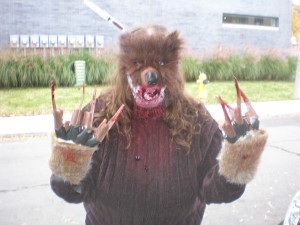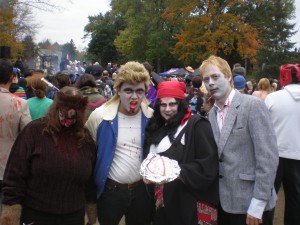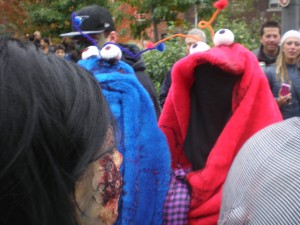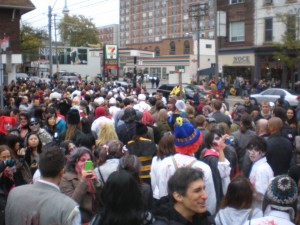Posts Tagged ‘Pop Culture’
It Came from Toronto After Dark: Deadheads
December 2, 2011These It Came from the DVR articles are going to be a little bit different. As an early Christmas present to myself, I picked up a festival pass to the Toronto After Dark film festival. So the first difference is that these are new movies, on the big screen, instead of old ones and niche programming on the small screen. The second difference is that these are going to be short. I’ve got eighteen films to see in seven days (as well as dressing up for the annual zombie walk), so I’m not going to have a whole lot of time to write, and I want post these while the blood is still fresh.
Toronto After Dark is a horror and genre film festival oozing with gobs of monster and rpg inspiration, but most of the films it showcases won’t see wide release – so in addition to extracting some rpg goodness from each movie, I’ll also give them a bit of a critique, so fellow gamers can know what they need to track down and what to avoid. I’ll try and keep spoilers to an absolute minimum.
Deadheads
Deadheads mashes together the unlikely genres of zombie, comedy, and road-trip movies to tell the story of Mike and Brent, two strangers that awake one day to find that they have become sentient zombies in the middle of a mindless zombie outbreak.
The two team up and set out on a cross country trek to find Mike’s girlfriend and carry out the marriage proposal he was planning before he died. Along the way the duo tries to cope with undead life and is pursued relentlessly by the shadowy organization that created them.
The Zom-Com With Heart
Toronto After Dark kicked off ‘zombie appreciation night’ (discounted tickets were available for those in costume – a great bit of cross promotion with the Toronto Zombie Walk) with Deadheads. The preview I had seen was pretty funny, but I was wary, as comedy is one of those things that can easily land way off the mark. Co-writer and director Brett Pierce was in attendance and introduced the film as a ‘zombie movie with a lot of heart’, and after seeing it, I have to agree.
There’s so much to like about Deadheads that it makes me want to overlook the film’s rougher patches, which, if you ask me, is the hallmark of something special. The low budget meant that some of the effects weren’t that great (I’m thinking of the digital fire in particular), but the zombie make-up was excellent (a sign that the Pierce brothers knew what was important to spend their limited budget on). Similarly, there were a few slow moments in the middle of the film, but there are enough laughs in the intro and finale to make up for it.
The immediate comparison will be with Shaun of the Dead, which is appropriate since Deadheads works for many of the same reasons its predecessor does (it even uses a similar font for its movie poster). Both films make excellent use of their romantic comedy trappings, poke fun at sometimes ridiculous horror conventions, and feature a hero who must find direction and evolve beyond a life as a directionless loser in the catalyst of an apocalyptic crisis (that last one carries a lot of traction with guys like me).
But what sets Deadheads apart is what it does differently. With the protagonists being zombies instead of fighting them, it’s sort of an inverse version of Shaun of the Dead (and if Romero-esque zombies are code for our consumerist society, finding a way to exist as a conscious zombie might ultimately be a more hopeful message). Also, while Shaun slips its romantic comedy into a survival horror plot, Deadheads uses the road trip movie as its primary plot device… which got me thinking about another Simon Pegg film, Paul.
Now Paul isn’t very good, but its shortcomings highlight what made me like Deadheads so much, and nothing demonstrates the difference between these movies more than a comparison of their respective sidekicks. While the self-titled alien of Paul is hard to look at, irritating and lacks any emotional depth (I’m being a little strong here, but I’m, trying to make a point), Cheese in Deadheads (a regular zombie Mike and Brent bring along in an attempt to train him to stop eating people) instantly connects with the audience with nothing more than a few grunts and facial expressions and has you rooting for the monster from the moment he appears on the screen. Seriously, if a film is able to make me care about the well-being of a mindless flesh eating zombie it’s doing something right.
Deadheads is recommended, and is a must-see for fans of Shaun of the Dead. It isn’t highbrow stuff, but it isn’t supposed to be, and it accomplishes what a good romantic comedy should – it gives the audience what they want and leaves them feeling uplifted.
RPG Goodness
The inversion between protagonist and monster that Deadheads plays with is not new territory for role-players. From early in D&D’s history, players have wanted to use nonstandard races and monsters as PCs (a style of play fully embraced by D&D 3.5’s Monster Manual). It could be that rpgs in general attract people that are a little on the margins themselves, who identify more with the monsters of film and literature than with the heroes. Or it could be that monster PCs just look cool and get a bunch of neat powers to play with. I don’t exclude myself from these observations, as my long running Minotaur gladiator (from 2e D&D) and piano playing vampire (from Rifts) can attest to.
Deadheads is a great example for role-players of the friction between living as a monster and dealing with everyday problems. Deadheads plays this for laughs, and truth be told that’s how these difficulties will probably manifest on most tabletops with monstrous PCs – that is when the party isn’t running from a disgruntled militia or a bunch of angry peasants with torches and pitchforks.
In spite of the popularity of monstrous PCs, the transformation into an NPC monster via infection (through lycanthropy or level drain for example) is still something every player avoids like the plague (zombie plague anyone?). I think the real in-game horror of such transformations has nothing to do with who is a monster and who isn’t, and everything to do with loss of control and agency in the game world. In that spirit I present disease rules modified from 4e for the Gamma World game and the Zed virus (also compatible for D&D games). For the carrier of this plague, the Romero zombie, see my review of Exit Humanity.
The Zed Virus
Disease in Gamma Terra
The laboratories of the ancients are a breeding ground for a cornucopia of genetically engineered super viruses, every bit as dangerous as the radiation and mutant horrors of the wastes.
When a creature is exposed to a disease – whether through a spray bottle of weaponized anthrax or the bite of an infected zombie – they risk contracting the disease. The transmission and effects of a disease follow three steps: exposure, infection and progression.
Exposure
A creature that is exposed to a disease risks contracting it. A creature is typically exposed to a disease through a monster attack (such as the bite of a Romero zombie), or environmental exposure (such as an ancient CDC lab). Unless the disease inducing attack or environmental description states otherwise, an exposed creature makes a saving throw at the end of the encounter to determine if exposure leads to infection. If the saving throw fails, the creature is infected.
If a creature is exposed to the same disease multiple times in the same encounter, it makes a single saving throw at the end of the encounter to determine if the exposure leads to infection.
Infection
Each disease has stages of increasing severity along a track. The effect that exposes a creature to a disease specifies the stage of the disease that applies when a creature is infected (if no stage is specified start with the initial stage). As soon as a creature contracts the disease, the creature is subjected to that stage’s effects.
Unless the disease is removed from the creature (through an origin power or Omega Tech), the disease might progress at the end of the creature’s next extended rest.
Progression
Until the disease ends, unless the description states otherwise, the creature must make a Fortitude check at the end of each extended rest to determine if the disease’s stage changes or stays the same. To make a Fortitude check, roll 1d20 and add your Fortitude score minus 10. A disease typically specifies two DCs. A check result that equals or exceeds the higher DC means the disease is getting better (and moves 1 stage left on the track). If the check result equals the lower DC, or is between the two numbers, the disease remains at its current stage. A lower check result means the disease is getting worse (and moves 1 stage right on the track).
An ally can attempt to care for a diseased patient (using ancient pharmaceuticals, alien nano-tech and whatever else they can scrounge together), substituting their own Science check in place of the patient’s Fortitude check.
When a creature reaches a new stage of the disease, it is subject to the effects of that stage right away. Unless the description states otherwise, the effects of the new stage replace the effects of the old one.
When a creature reaches the final stage of the disease, it stops making checks against the disease. The effects of the final stage are permanent, although a cure might be found in an ancient computer databank, a crashed alien mothership, or growing in one of the seedpods of the sentient mega plant Columbia.
Notes
First I have to give props to Erik Fry, whose blog Dear God What Have We Wrought?! got me thinking about the mechanics of a zombie plague in Gamma World. I went in quite a different direction than he did, but it’s worth checking out if you want a ‘second opinion’ (does this thing look infected?).
While combing through the Gamma World books for mention of disease, I noticed that a few of the character origins (Plaguebearer and Reanimated) have immunity to disease as a character trait. Either designers Richard Baker and Bruce Cordell assumed Gamma World referees would hack the 4e disease rules, or the expansions Famine in Fargo and Legion of Gold were originally intended to have rules for disease. Either way, it makes it a lot easier to introduce disease into the game since the designers already paved the way by giving it consideration.
It Came from Toronto After Dark: Redline
November 12, 2011These It Came from the DVR articles are going to be a little bit different. As an early Christmas present to myself, I picked up a festival pass to the Toronto After Dark film festival. So the first difference is that these are new movies, on the big screen, instead of old ones and niche programming on the small screen. The second difference is that these are going to be short. I’ve got eighteen films to see in seven days (as well as dressing up for the annual zombie walk), so I’m not going to have a whole lot of time to write, and I want post these while the blood is still fresh.
Toronto After Dark is a horror and genre film festival oozing with gobs of monster and rpg inspiration, but most of the films it showcases won’t see wide release – so in addition to extracting some rpg goodness from each movie, I’ll also give them a bit of a critique, so fellow gamers can know what they need to track down and what to avoid. I’ll try and keep spoilers to an absolute minimum.
Redline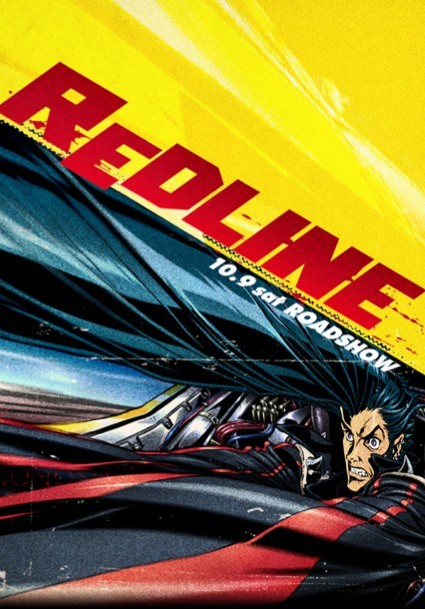
Redline is the animated magnum opus of writer and character designer Katsuhito Ishii, better known in the west as the man responsible for the animated sequences of Kill Bill Vol. 1.
Set in the far flung future, the film follows racecar driver ‘sweet’ JP as he works to qualify for the titular race and move past his days of throwing competitions for the mob. The redline grand prix is deadly, there are no rules and contestants vehicles frequently sport missiles and other weaponry. Because of the collateral damage it causes, redline is held on a different planet each race, the location kept secret until days before the meet.
This Is Your Brain. This Is Your Brain on Redline.
Wow. I wasn’t sure if I was going to make this screening, as it happened smack in the middle of the zombie walk, but I cheated a little (transforming into a fast zombie for a few blocks), and I’m really glad I made it.
I used to be a huge fan of anime, but over the years I’ve sort of drifted away, and haven’t been as zealous keeping up with the latest series and movies. Redline re-ignited my interest and reminded me of the best of what the genre has to offer.
First of all, it’s absolutely beautiful to look at. The highly detailed, hyper-stylized world is full of lurid colors that match perfectly with the high adrenaline story being told (‘high adrenaline’ isn’t quite a strong enough descriptor – more like ‘crank fuelled heart attack’). If you can, see it on the big screen (or at least a big TV) and turn up the volume (the soundtrack was appropriately ‘high energy’). We’ve all heard about seizure inducing anime before, but Redline was the first time I actually thought it could happen.
One more note about the animation. It’s all hand drawn. That means no computer generated vehicles. Honestly, the movie is worth seeing just for that alone (seeing CGI and classical animation jammed together is one of my pet peeves – like a grain of sand in your eye).
Because they share a similar subject matter and medium, the obvious comparison for this film is the classic Speed Racer series, but I think a much better analog is the original Roger Corman classic, Death Race 2000. Both films feature a dystopian future where the race is seen as a way to transcend an oppressive regime, both are light on plot but heavy on the interplay between larger than life racers with tricked out gimmicky cars, and (most importantly) both films share the same sense of fun. The main difference being that Redline pulls off stuff Corman wouldn’t have thought of in his wildest dreams.
Yes, Redline is ridiculous, but the movie keeps on pushing until it becomes sublimely ridiculous. I counted at least four moments during the screening when the whole crowd burst out into spontaneous applause, and I can’t remember the last time I ever saw that during an animated feature.
There isn’t a boring racer in the pack (which is an achievement for any racing movie): bosozoku inspired JP, a cyborg that’s a part of the car, a pair of magical (yes, magical) pop stars that ride in their anthropomorphic vehicle’s boobs, a pair of bounty hunters (one of whom looks exactly like Zoltar from Battle of the Planets) – the most vanilla of all the drivers is love interest Sonoshee and her nickname is ‘cherry-boy hunter’!
Redline is highly recommended, not just for anime fans, but really anyone who wants to see how you can do gonzo right.
RPG Goodness
There is a lot of inspiration crammed into Redline’s 102 minutes. Character concepts, crazy names (my favorite: a Godzilla sized bio-weapon codenamed ‘Funky Boy’), and interesting weapons (the Zoltar-esque bounty hunter has a siege sized grappling gun that tethers his vehicle to faster ones with a chain). All are prime fodder for the rpg table, but the core of Redline is the race, an element that isn’t featured in too many tabletop rpg adventures, despite it being a staple of the action/adventure genre.
Adding a race into D&D is a perfect opportunity to make a skill challenge. I know there are mixed feelings about skill challenges for 4e, but it’s a subsystem that I think is robust enough to both represent a wide variety of activities and also survive judicious tweaking (making it a kind of ‘mini-game’, at the risk of using a dreaded video game term and giving the 4e haters some ammunition).
I should note this skill challenge is a bit different than most, in that it includes a random table and isn’t resolved by the traditional successes vs. failures format (by its nature a race is a competition between individuals). I thought adding some random mayhem into the challenge would be fun and would reflect the craziness of the film.
The Great Race
“It only happens once a decade – a race so dangerous that simply surviving to reach the finish line is a goal worthy of glory. There are no overseers. There are no rules. There is only speed and the blood of the fallen on the dusty road.”
Setup: First, determine the enemy racers. These should equal the number and level of the PCs participating in the race (higher level monsters can be used for a harder challenge, and the number of enemy racers can be decreased if an elite or solo monster is used, or increased if minions are included).
Second, determine the length of the race. Short races are 5 rounds, long races are 10 rounds, and grueling endurance matches are 15 rounds (expect most racers not to finish).
Level: Award XP equal to the value of the monsters used as enemy racers. In long races add additional XP equal to a single monster of the party’s level. In endurance matches add additional XP equal to a pair of monsters of the party’s level.
Running the Challenge: During the first round of the race, roll initiative as normal. In subsequent rounds initiative order is determined by track position, with pole position (1st place) acting first. Using miniatures to determine track position is helpful, but remember, the position on the track is an abstract way of determining where the racers are, not an accurate measure of distance in squares.
Each round, roll on the random event table to set the tone for that leg of the race. Effects from the random event table are applied to racers at the start of their turn.
During their turn, a racer can either advance, block, attack, or recover.
To advance, a racer attempts a moderate skill check. Success indicates the racer has moved up 1 position. Racers who fail this check do not move. If the racer is attempting to move into a position with an enemy blocking creature, the skill check is instead hard. Appropriate skills to advance include (but are not limited to): Acrobatics, Athletics, and Nature (In Gamma World use Str/Con, Dex/Int, and Mechanics checks instead).
Racers can use their turn to block. This makes it more difficult for other racers to enter their position, but also makes it difficult to avoid enemy attacks. Any creature actively blocking grants combat advantage.
A racer can try and attack his opponents to eliminate the competition or settle a personal grudge. A creature can make a melee attack against a racer in the same position, a close attack against a racer in the same or an adjacent position, or a ranged/area attack against a racer one position distant or an adjacent position.
Finally, a racer can take their turn to recover. This allows a racer to take a second wind (allowing the racer to spend a healing surge and granting a +2 bonus to defenses for the round). Unlike the previous actions, a racer can only recover once a race.
At the end of the final round of the race, the racer in the pole position wins. In the event of a tie, all racers in the pole position make a final skill check to advance, and the racer with the highest score wins.
Since the PCs will likely be working together, don’t have the monster racers attack one another (it would become too easy), but don’t have them cooperate in coordinated group attacks either (unless you divide the monster racers into ‘teams’, in which case each team will work together as much as possible).
Optional: If you want the race to be more involved, include the mounts and vehicles for each racer (especially if one or more of the PCs has the mounted combat feat). In this case, close and area attacks affect both racer and mount, while melee and ranged attacks affect either the racer or the mount.
If a racer uses an action point they are able to take two different actions during their turn (but not two of the same action).
Toronto Zombie Walk
October 29, 2011Luckily it didn’t rain and my costume was warm enough that the cold didn’t matter. The walk has really grown since the first time I attended, and was easily six-thousand strong. This year even featured the walk’s founder and organizer, Thea Munster (I hope she kept her own name), getting married in a public zombie wedding. I was too busy trying to find parking, so I missed the ceremony, but got to see the awesome costumes of the bridal party.
In addition to greater zombie attendance, there were also plenty of spectators checking out the costumes and taking pictures. I have to admit it was pretty cool stopping to pose for pictures from the ‘paparazzi’. With people watching it was easier to ham it up and get into character, and with thousands of other people doing the same thing I didn’t feel the least bit self-conscious (the fact that I was wearing a mask that I could barely see out of helped too).
Speaking of pictures, I managed to snap a few of my own. Apologies for the crappy photography, I was wearing fake nails (zombie claws) which reduced my manual dexterity to about zero (click on the picture for full-size)
The zombies slowly swarm out of the park, absolutely overrunning Queen Street.
It Came from Toronto After Dark: Father’s Day
October 27, 2011These It Came from the DVR articles are going to be a little bit different. As an early Christmas present to myself, I picked up a festival pass to the Toronto After Dark film festival. So the first difference is that these are new movies, on the big screen, instead of old ones and niche programming on the small screen. The second difference is that these are going to be short. I’ve got eighteen films to see in seven days (as well as dressing up for the annual zombie walk), so I’m not going to have a whole lot of time to write, and I want post these while the blood is still fresh.
Toronto After Dark is a horror and genre film festival oozing with gobs of monster and rpg inspiration, but most of the films it showcases won’t see wide release – so in addition to extracting some rpg goodness from each movie, I’ll also give them a bit of a critique, so fellow gamers can know what they need to track down and what to avoid. I’ll try and keep spoilers to an absolute minimum.
Father’s Day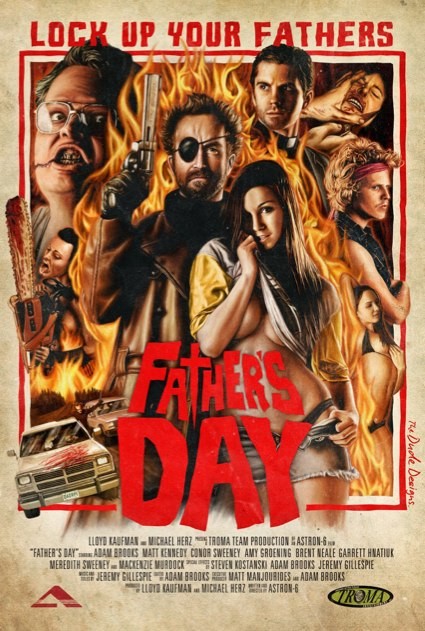
A co-production between Canada’s up and coming, indie film collective Astron-6 and the infamous Troma studios, Father’s Day is the story of vengeance obsessed, one-eyed Ahab and his search for his father’s rapist and murderer, serial killer Chris Fuchman. Fathers are the exclusive target of Fuchman’s depravity – hence the title of the movie. Ahab is joined on his quest by his estranged sister Chelsea (now a stripper), male prostitute Twink (his own father a recent victim), and neophyte priest Father John Sullivan. Gore, nudity and mayhem ensue.
Over the top, retro exploitation
I will admit up front that this movie was not my cup of tea, but I don’t want anyone who reads this to give the film short shrift, because I know there are people who are absolutely going to love Father’s Day. What the movie does, it does brilliantly; I just happen to not really be a fan of the exploitation sub-genre, so most of the work was lost on me.
The Astron-6 guys did an amazing job of capturing the feel of late seventies/early eighties grindhouse pictures, from the look of the film stock (even though it was shot digitally) and minimalist electronic score to the gory special effects (even the movie poster looks like it came from that period). While much of the humour in those older films was unintentional, the laughs in Father’s Day are no mistake.
Since I wasn’t that into other aspects of the film (the torture for instance), I appreciated the comedic bits, which had me laughing out loud. The jokes in the film are a strange (and contradictory) mixture of witty and stupid, often poking fun at many of the horror genre’s unquestioned staples (there are a couple in there I absolutely loved: a kiss for the dying, hallucinogenic berries, the aftermath of the dam fight and the movie’s ending stand out).
Special mention should be made of the gore, which was appropriately over the top. In the Q&A after the screening, the filmmakers described the process they used to prepare the guts of eight pig carcasses for the effects – which had to be done in their own bathtub (a horror show itself). Gore hounds can be rest assured that Father’s Day delivers (including some pretty gruesome genital mutilation).
There was also some funky stop-motion animation thrown in there, which was nice to see, and a hilarious commercial for a Star Wars rip-off halfway through (the film is set up as though it were playing on late-night television).
What I think makes Father’s Day stand out from other recent efforts at retro exploitation is its willingness to subvert the genre (while still clearly enamoured of it). I’ve already mentioned the humour, which works well to this end, but I think the most subversive element of the movie was Astron-6’s choice to make the serial killer rape and murder men (graphically). In horror films (and especially exploitation films) there is a tendency to present women as fetishized objects of sadomasochistic fantasy. I think that modern horror filmmakers too easily swallow this ‘tradition’ without question (no disrespect intended, but I was thinking about Rob Zombie when I wrote that), and perpetuate it. As hard as these scenes are to watch in Father’s Day, I appreciate the point that Astron-6 was making by inverting the convention.
I can honestly say that this was the best Troma movie I have ever seen (which isn’t exactly glowing praise I guess). Father’s Day is recommended for fans of grindhouse exploitation. If you liked I Spit on Your Grave, or Hobo With a Shotgun then this movie is for you. If these kinds of movies aren’t your thing, then Father’s Day isn’t going to change your mind, but at least you’ll get a few good laughs.
RPG Goodness
I like to think that I can draw inspiration from any source, but the subject matter of this movie makes it difficult, to say the least. I would be completely creeped out if my DM ran an adventure based on Father’s Day or statted up the Fuchmanicus for my character to fight, so I won’t be doing either. There was, however, a plot point in the movie that I’ve often thought about incorporating into a campaign…
SPOILER ALERT (seriously, it’s a big one)
In the film, the heroes, in their quest to destroy a demon, must journey to hell to confront it (which immediately reminded me of the 1e D&D convention regarding demon lords and arch devils being destroyed on their home plane). Unfortunately, the only way the heroes can think of to get to the underworld is by committing suicide. In the movie this is played for laughs, but it got me thinking about character death in rpgs.
What if character death were a part of the plot of the adventure, rather than something to be avoided and bypassed (through raise dead)? Now I’m not talking about self-sacrifice (jumping on a grenade to save the party, or hurling yourself into Mount Doom with the One Ring), which I think is common enough in tabletop games. I’m talking about death being the way to overcome an in-game obstacle, like travelling to the lower planes (or the Shadowfell in 4e).
I can think of two D&D products that used character death in this way. The Ghostwalk campaign setting for 3e had dead PCs return as ghosts. Since living characters and ghost characters each had their own strengths and weaknesses, it was advantageous for a party to include both (and not inconceivable to design encounters and obstacles that could only be bypassed by one or the other). The cult classic videogame Planescape: Torment also included a plot point where you could kill yourself to access sealed off areas of the Dustmen’s mausoleum.
Both examples have one key element that I think is important – character death is not final or immutable (because you wouldn’t really be overcoming an obstacle if you were permanently dead would you?). So in our hypothetical campaign where the PCs have to travel to the Shadowfell to combat the forces of Orcus, perhaps at the end of the adventure, as a reward, the Raven Queen can return them to the world of the living.
Alternatively, I think it would be interesting to have death be a side-trek adventure all itself. If a PC dies he or she must complete a small quest in the underworld to return to life (similar to the cliché of challenging Death to a game of chess), assisted by shadow versions of the rest of the party, conjured from the hero’s subconscious. Prophecy is often associated with near death experiences, so instead of treasure and experience points, this kind of adventure can reward the PCs with clues and information about the current campaign. This prize might even be enough to tempt desperate PCs…
Of course this only works if death is relatively rare in the game you are running. Having to run a side trek every other session will quickly become distracting and annoying (not to mention a lot of extra work).
It Came from Toronto After Dark: Exit Humanity
October 25, 2011These It Came from the DVR articles are going to be a little bit different. As an early Christmas present to myself, I picked up a festival pass to the Toronto After Dark film festival. So the first difference is that these are new movies, on the big screen, instead of old ones and niche programming on the small screen. The second difference is that these are going to be short. I’ve got eighteen films to see in seven days (as well as dressing up for the annual zombie walk), so I’m not going to have a whole lot of time to write, and I want post these while the blood is still fresh.
Toronto After Dark is a horror and genre film festival oozing with gobs of monster and rpg inspiration, but most of the films it showcases won’t see wide release – so in addition to extracting some rpg goodness from each movie, I’ll also give them a bit of a critique, so fellow gamers can know what they need to track down and what to avoid. I’ll try and keep spoilers to an absolute minimum.
Exit Humanity
The first of several zombie films in the festival, Exit Humanity follows the trials of Civil War veteran Edward Young as he deals with a horrifying zombie outbreak that threatens to destroy everything he holds dear. The movie is framed as the chronicle of Edward’s Journal, the action interspersed with narration and small animated vignettes.
Slow Burn, Character Driven, Horror
With all the zombie action at After Dark this year, Exit Humanity was the movie I expected the least from, and I was very pleasantly proven wrong. I wasn’t sure how the animated segments would mesh with the rest of the picture and I was worried it would ruin the immersion. It didn’t. In fact, combined with the excellent, gravelly voice over of Brian Cox narrating, the journal sequences really helped to pull the movie together and keep it moving forward.
The most surprising element of the film though, was the lead, newcomer Mark Gibson. Genre movies and zombie movies in particular, are not exactly known for their displays of acting talent, so a zombie film that’s a character driven narrative with a slow emotional build seems doomed to failure from the start, but Gibson carries the weight. Yes there are a few Anakin-shout-at-the-heavens moments, but Gibson honestly delivers a depth of emotion almost unseen in movies of this budget.
The score was also excellent. Creepy, slow banjos transport you to the period and are absolutely perfect for the lonely tracts of wilderness, devoid of human life, where the story takes place.
For all my praise, I do think Exit Humanity was longer than it should have been. Don’t get me wrong, I appreciated the time it took on screen for the characters to develop their relationships (it lent the events more emotional weight), but there were parts that really dragged. There is action and excitement, but if you’re looking for a high-octane, zombie splatter fest, this is not it.
Exit Humanity is recommended, especially for fans of character driven horror, like The Walking Dead (the ties to this series are even more direct – the zombies in the film are even called ‘walking dead’), or for fans of Westerns (plenty of zombie and six-shooter action). In fact the film is a great gateway for fans of one genre to test the other. I can see an awesome viewing party where Exit Humanity is presented between The Walking Dead and the recent remake of True Grit.
RPG Goodness
If you play or are interested in the Deadlands rpg, then Exit Humanity is practically required viewing. It’s not a perfect match, but I think you’d be hard pressed to find a better film to get new players in the mood for the setting.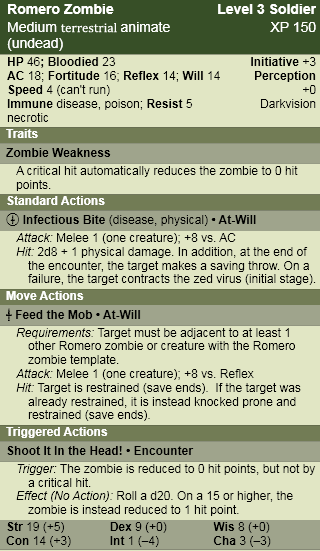
Without giving away any spoilers, Exit Humanity, like many zombie movies, focuses on the mechanics of the infection and transmission of the zombie plague as a plot point. In spite of 4e D&D’s embrace of some elements of Romero style zombies (the ‘shot to the head’ in the form of the zombie weakness trait), the game has yet to introduce a zombie with a plague spreading bite (there are some good 3e examples – my favourite is from the 3e Dark Sun adventure in Dungeon magazine 110). To correct this, I present the Romero zombie (in Gamma World format, since that’s what I’m playing lately).
The description of the zed virus and Romero zombie template isn’t missing (well, not by accident), it will just have to wait until later in the week. There are at least two more zombie films in the festival and I need to save some crunchy material for them.
Romero Zombie
“Every dead body that is not exterminated becomes one of them. It gets up and kills! The people it kills get up and kill!”
Named after the creator of a series of documentary videos scavenged from the cities of the ancients that chronicle first-hand accounts of the monsters’ attacks, Romero zombies are carriers of the highly virulent zed virus that wiped out their own worldline. Ironically, it is the predations of killer robots, malevolent extraterrestrials, mutant plants and radioactive monsters from other apocalyptic worldlines that keeps the virus from overwhelming this reality.
It Came from Toronto After Dark: Monster Brawl
October 22, 2011These It Came from the DVR articles are going to be a little bit different. As an early Christmas present to myself, I picked up a festival pass to the Toronto After Dark film festival. So the first difference is that these are new movies, on the big screen, instead of old ones and niche programming on the small screen. The second difference is that these are going to be short. I’ve got eighteen films to see in seven days (as well as dressing up for the annual zombie walk), so I’m not going to have a whole lot of time to write, and I want post these while the blood is still fresh.
Toronto After Dark is a horror and genre film festival oozing with gobs of monster and rpg inspiration, but most of the films it showcases won’t see wide release – so in addition to extracting some rpg goodness from each movie, I’ll also give them a bit of a critique, so fellow gamers can know what they need to track down and what to avoid. I’ll try and keep spoilers to an absolute minimum.
I had planned to post a Monsters of the Hyborian Age article before doing another It Came from the DVR, but as is usual, life got in the way and I ran out of time before Toronto After Dark crept up on me. I’m working on Queen of the Black Coast, easily one of the best written Conan tales, and I want to do it justice.
Monster Brawl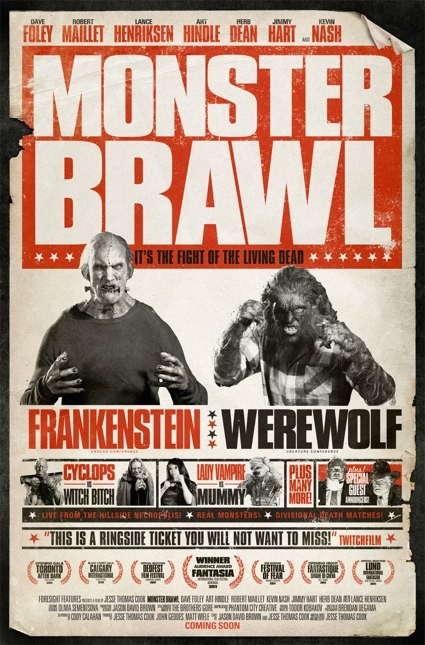
Can there be a better pairing than Ménage à Monster and a festival that opens with a movie called Monster Brawl? The plot is simple. A lonely wrestling ring, set up in the middle of an abandoned hilltop cemetery, is host to the world’s first pay-per-view monster brawl; an extravaganza that brings together monsters from across the globe to fight one another in no-holds barred death matches in the name of glory and entertainment (complete with WWF style smack talk between the matches).
The matches are divided into two conferences, the undead (featuring the Mummy, Lady Vampire, Zombie Man, and Frankenstein) and the creatures (featuring Cyclops, Witch Bitch, Swamp Gut, and Werewolf), with the heavyweight champion of each conference facing off in a final match for the title belt.
An Unabashed, Fun B-Movie
Monster Brawl isn’t for everyone, but I have a feeling that if you’re reading this blog then it might just be for you. It embraces its b-movie nature and runs with it, not wasting anyone’s time with a lot of exposition explaining why the monster brawl is taking place or adding some kind of narrative that pushes the viewer into rooting for one monster over another (they are all given fairly equal screen time – though the Mummy, Frankenstein and Swamp Gut were clear crowd favorites at the festival). Director Jesse Cook knows exactly who his audience is, classic monster lovers who’ve ever wondered if a zombie or the gill-man would win in a fight, and he delivers.
Like many of us who grew up in the eighties, I was a huge wrestling fan, so it was nice to see Jimmy ‘the mouth of the south’ Hart (who was at the screening and absolutely hilarious in person) in the picture. Monster Brawl manages to capture the feel of those old WWF days, before wrestling began to take itself too seriously, by using larger than life (if 2 dimensional) characters, plenty of humor, and over the top action.
There’s also more than a little bit of Darkstalkers in the DNA of this movie. Not only is the set-up similar to the popular series of fighting games, Lance Henrikson’s disembodied voice provides videogame-esque commentary throughout the matches (“magnificent combo!”) – I half expected to hear him shout “finish him!” – but I guess that would have caused some problems with the Mortal Combat people.
The makeup and effects were decent, which is surprising considering the film’s budget, with really only the Cyclops’ big unblinking eye looking a little crap. Still, I’ll take imperfect practical effects and traditional makeup over the kind of on the cheap CGI that other low budget studios spit out any day of the week (I’m looking at you Asylum – Megashark vs. Crocasaurus was unwatchable).
In order to keep costs low, Director Jesse Cook edited Monster Brawl himself, but the editing could have been tighter, especially in the first half of the film, where the shots seemed to hang on for a few seconds longer than they should have. It might not annoy others like it annoyed me, but I’m a firm believer that editing is one of those things you should never notice in a movie when it’s done right.
I was also a little disappointed that the monsters displayed fewer supernatural powers than I expected. It would have been great to see the witch cast a spell or the vampire summon a swarm of bats. Again, I suspect it was budgetary concerns that kept that kind of thing to a minimum, but it makes you wonder why the filmmakers included a witch among the monster lineup in the first place.
Ultimately, Monster Brawl is best enjoyed in a party atmosphere, with lots of cheering and jeering, just like a live wrestling match. The Toronto audience was great (we Torontonians have a reputation for being a high energy, engaged audience at things like After Dark and the TIFF’s Midnight Madness screenings), but I worry the film would lose a lot of its fun if viewed at home alone.
Monster Brawl is recommended, especially if you can rustle up some friends and beer to enjoy it with.
RPG Goodness
Most DMs in a D&D campaign might balk at adding in such a recognizable ‘named’ monster as Frankenstein into their game (even though everyone knows Adam and Strahd from the Ravenloft setting are Dracula and Frankenstein). However, on Gamma Terra I think that a fight against Frankenstein’s monster would make a great encounter – especially if the GM wanted to incorporate themes from Frankenstein Unbound (and since the whole reality collapsing in on itself is what happened in Gamma World it’s entirely appropriate). Here are the Gamma World stats for your very own monster brawl (created by modifying the stat block for the flesh golem).
Frankenstein’s Monster
“Yes, if you want to be a jerk about it, it’s technically just called ‘the monster’. Try telling that to it when you’re being pounded into the ground like a tent peg.”
In countless world-lines crazed scientists searching for the secrets of life have created, re-created, and re-animated this misunderstood homicidal construct. In return, it protects the one who breathed life into its collection of parts, whom it affectionately calls father (regardless of the individual’s actual gender). Some believe the monster kills so its ‘father’ can use the raw material to construct it a bride. Whether or not such abominations could create offspring is a question best left unspoken.
It Came From the DVR: Vampires vs. Zombies
October 9, 2011When I was younger, I used to love nothing more than staying up all night in the cathode ray glow of the television with a bottle of caffeinated beverage by my side, watching such late night fare as Incredible Hulk reruns, badly dubbed kung fu flicks, and rubber suited monster movies. They were hardly Shakespeare, but I’ve found inspiration for writing and gaming in even the darkest dregs of cable television (not everything is redeemable – Charles in Charge comes to mind).
Now that I’m older and (slightly) more responsible, my DVR stays up all night for me, recording a smorgasbord of visual junk food. In this series, I boil that junk down and extract the interesting bits – campaign ideas, adventure locales, encounter set pieces, and of course, monsters.
Spoiler Alert! Yes, spoilers are going to abound. When dissecting a movie or television show to find the hidden awesomeness, you’re bound to reveal things about the plot.
Deadliest Warrior
I am a big fan of Deadliest Warrior. Each episode they use a computer simulation to pit two of history’s greatest warriors against one another, collecting data about weapons, armour and fighting techniques along the way. Yes it’s cheesy, it’s arbitrary and the Americans always win (which is even easier to ensure this season, with the addition of highly subjective ‘x-factors’ to the criteria), but I am a sucker for any show with gratuitous slow motion shots of pig carcasses and ballistics gel torsos being hacked to pieces (I also love Mythbusters). Plus, the trash talk between experts is hilarious.
From a gamer’s perspective, it’s a little like watching Gygax’s fetish for arms and armour come to life, albeit with a few less pole arms. After spending years with some of these weapons on paper, it’s nice to see them in action. Of course, if you’re reading this blog, the odds are you’ve already seen the show. There’s a lot of overlap in the Venn diagram describing people who are gamers and people who wonder if a ninja would win in a fight with a pirate. And if you haven’t seen the show yet, it’s definitely worth checking out for that alone – but I want to talk about the finale.
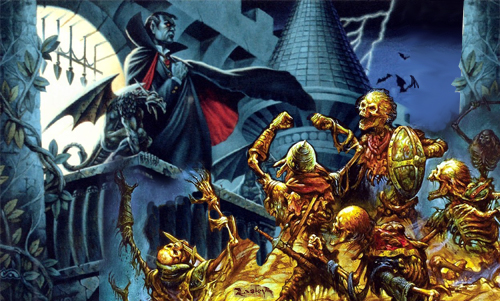
Vampires vs. Zombies
Now, normally the show deals with real historical figures and martial traditions, but for the season three finale the producers decided to take a sidestep into folklore and pit two iconic undead monsters against one another (depicted here in a mash-up of Clyde Caldwell’s cover of Ravenloft and Jeff Easley’s cover for The Magister). To give their professional opinion and help with the testing, Steve Niles (author of 30 Days of Night, representing the vampires), and Max Brooks (author of World War Z, representing the zombies) were brought in as experts. As would be expected, both by the type of tests they run on the show, and by the version of the undead presented in both Niles and Brooks’ work, the show assumed biological versions of vampires and zombies instead of supernatural ones (so no flying or transmutation for the vamps, and no magically animated body parts attacking on their own for the zombies).
The episode was a lot of fun, and even more gruesome than usual. I heartily approve of using dog and crocodile bites as analogs for the impact of zombie and vampire bites. Once the data was collected, Deadliest Warrior moved on to the real highlight – a hydraulically powered biting machine they used to chew apart a couple of ballistics gel torsos made up to look like a vampire and a zombie to measure the damage the monsters could inflict on one another. The vampire stand-in even had a pumping jugular so they could time how long it would take the creature to bleed out if a zombie got a lucky hit (like I said, they went for the more biological version of the vampire – so they needed blood to survive). I also have to congratulate Max Brooks for taking the smack talk to a whole different level. I easily could have watched a half hour of him bad mouthing vampires and it still would have been entertaining (but then I would have missed out on the biting machine, which would have been a crime).
Not surprisingly, even with the advantage of overwhelming numbers on their side, the zombies lost. Which, as big a fan of zombies as I am, is at it should be. Zombies are mindless, and really only have one strategy, while vampires are at least as smart as mortal humans. They also had the vampires fighting with their teeth and claws, when they could have easily used any of the human weapons featured on the show from the past three seasons. Zombie movies are great, and I think they make a better metaphor for our consumer capitalist society than vampires do, but in an actual fight – vampires win. But really, why would vampires and zombies fight at all? Wouldn’t vampires simply avoid an approaching zombie horde since they don’t have anything to gain by destroying them?
My partner and I usually like to bet on Deadliest Warrior, and in our ‘post-game’ debate these questions came up, which got me thinking (yes we will argue with each other about anything, which should be obvious by how seriously I am taking such a ridiculous show). In combat it’s true that vampires would mop the floor with zombies (as the dramatized portion of the show demonstrated), but when two predators compete with one another in an environment, that’s rarely the factor that determines survival. If it were, the world would be swarming with smilodons and megalodons. Predators compete with one another by stealing the other’s food source.
The problem for vampires is this: both vampires and zombies have the potential to infect others and create spawn, but vampire spawn compete for food (living blood) with their creators so it’s not in the vampires’ best interest to create too many, while zombies just keep making more zombies (since they are mindless and exist only to spread their virus anyway). So while vampires may win the proverbial battle, they will most likely lose the war, as the zombie plague spreads like wildfire amongst their food supply and the vampires are left to die of starvation on a dead planet filled with wandering corpses. It would also put vampires in the strange position of having to risk their ‘lives’ to shield humanity … a scenario rife with possibilities for role playing games.
The Planet of the Dead Campaign
This campaign works best with any post-apocalyptic rpg: Rifts, Gamma World (Gamma Rifts even!), D20 Apocalypse, Mutant Future… but it could also easily work with D&D (especially if you wanted to use the world ending arrival of Atropus from Elder Evils), or even a dark take on Mutants and Masterminds (think Marvel Zombies and the Midnight Sons). Hell, you could probably even use something like Palladium’s Invid Invasion for the Robotech rpg (imagine riding a red and black, vampire built cyclone through the wastelands, fighting giant, gestalt mega-undead formed from the lashed together bodies of hundreds of zombies).
Here is a breakdown of the campaign arc such a game might take.
Outbreak
This short adventure makes a great prequel to the campaign and sets up both the relationships of the PCs as well as setting the tone for adventures to come.
Hours before the global outbreak of the ‘zed virus’, the characters are investigating a series of murders on their home turf. The victims have been drained of blood and suffered horrible neck injuries (which should raise a lot of flags amongst the players). As the deceased are all from vulnerable populations (homeless and sex trade workers), the authorities (police, city watch, etc.) have shown little interest in finding the perpetrator, so it falls to the PC’s to get to the bottom of things (perhaps they were even contacted/hired by the family of one of the victims).
The reality is that a powerful clan of vampires, known as ‘the family’ is using their influence to cover for the indiscretions of one of their more reckless members (you can’t do an end of the world game without at least one nod to The Omega Man). The family is important in the campaign, but doesn’t appear again until the late stages of the game.
The PCs can follow the clues left by the careless vampire to an old tenement building it has been using as a lair (its behaviour has estranged it from the rest of its brethren), but the clock is ticking. Outside, the zed virus is spreading faster than in can be contained, and a shambling horde of the undead is headed the PCs’ way. The vampire seems like the least of the party’s worries when the zombies show up.
An interesting climax to the adventure could be an encounter that transforms from and invasion of the vampire’s lair to a defense of it (perhaps making a temporary truce with the vampire, or maybe a gory three way battle).
Survival
Fast forward six months (or a year) and the world has not fared well. Society has crumbled, the government no longer exists, and the organized war against the zombies has been lost. The battle for survival begins.
The PCs can be wandering nomads, foraging for equipment and supplies, or they can be holed up behind makeshift barricades, venturing out on short treks for food and medicine. This kind of format makes this portion of the campaign perfect for short, goal-oriented adventures (find food, rescue loved ones, etc.), that emphasize the demoralizing hellscape of the post zombie apocalypse.
Dangers abound, not just from zombies, but from other more predatory survivors, the environment and starvation. Encounters with zombies should be varied – the Resident Evil series of games did a great job of making a wide range of monsters to fight by having the t-virus constantly mutating and infecting different animals in different ways (and if the game system already has all kinds of strange creatures you can really go to town when introducing the zed virus).
Getting an infectious zombie bite should always be a threat, but in an rpg it can’t be as virulent as it is in the movies (unless you’re running a Call of Cthulhu game I guess). Players generally expect a higher degree of survivability for their characters than you get in the average horror movie. If you need an in-game reason the PCs get a saving throw, or (if you are using a 4e-style disease) can get better from the virus, perhaps they already have some in-built resistance to the plague that the average person doesn’t benefit from (in a fantasy campaign maybe they have been blessed by the gods, or drank water from a magical fountain).
Pepper these short adventures with rumours of a zombie-free colony of survivors that’s been founded some distance from town (however far it needs to be to make the travel dangerous and memorable). The worse things get where the characters are, the more likely they are to take the hook (and if they were already nomads, getting to this sanctuary may have been their goal all along).
Asylum
Hungry and ragged from the journey, the PCs arrive at the colony, a self-contained complex of hi-tech buildings, complete with armoured greenhouses and its own nuclear power plant (or an impenetrable, walled city with its own self-contained vineyards and orchards in a fantasy game). Amazingly, the colony is as zombie free as advertised and welcomes the PCs with open arms. The place is floor to ceiling gleaming white tile and chrome, bright fluorescent lighting, and most importantly, fully equipped with clean, running water (in a fantasy game the colony would be a neo-classical daydream of the Acropolis, filled with white marble and mathematically precise colonnades). In exchange for residency, given the PCs’ skills, all they need to do is volunteer for the colony’s defense force.
At this point in the game an easy, by the numbers adventure will lull the players into accepting the colony at face value (or not, most rpg players are a pretty suspicious lot – but that’s OK too, the game doesn’t hinge on them being trusting). Under orders from the defence force, a daytime raid against a group of uninfected bandits, or a simple seek and destroy mission to clear a group of undead from a nearby roadway would be good fits.
Once they have begun to settle into their new life, throw the occasional clue about the colony’s true purpose the party’s way: in spite of the steady trickle of survivors coming in, the colony never seems to run out of room or resources; the PCs have never met or seen any of the people who defend the colony through the night; the colony’s leaders are constantly shifting people from one living area to another – every week it seems the PCs have new roommates and neighbours; there is no crime in the colony, yet the PCs haven’t seen any internal police. It won’t take much for the PCs to want to investigate further.
The Bloody Truth
Eventually the PCs will use whatever means they have (force, guile or subterfuge), to get to the bottom of who really runs the colony – a group of vampires called the family (possibly including the vampire they fought at the beginning of the campaign, if it escaped), protecting a small pocket of humanity from the zed virus to preserve their food supply.
The PCs might stumble onto direct evidence of the family (using whatever means of vampire detection are suitable to the game and type of vampires it features), or they may break into the core of the family’s secret activities in the colony – a cavernous, refrigerated vault underneath the colony’s reactor that houses a living blood bank. Hundreds of comatose humans, hooked into a web-like network of intravenous tubes, some providing just enough sustenance to keep these poor souls alive, while the blood they produce is slowly leached away by others (a fantastic image courtesy of the film Daybreakers).
As more and more survivors make their way to the colony, the family adds more bodies to the blood bank, always making sure to keep enough free humans to supply a healthy breeding stock. Preference is given to those humans with highly trained skills, powerful defenders (like the PCs), and pregnant women. Criminals, agitators, and dissidents are all prime candidates to be taken to the blood bank.
Endgame
The endgame of the campaign is completely dependent on the actions of the PCs (which goes without saying for any part of the campaign, but here especially so). As distasteful as it is, the party might decide to maintain the status quo. Sacrificing a portion of the population might be deemed a worthwhile price for the vampires’ protection against the zed virus and the continuance of humanity. The challenge for a party that takes this road is in convincing the family that they will keep the vampires’ secret. Doubtless the family will arrange for tests of loyalty which might be as dangerous as fighting the vampires themselves (and since the family’s opinion might not be unanimous, this is a great opportunity for high stakes political intrigue and espionage).
Most rpgs are action oriented, and many of the players I know would want to take the other road, overthrow the family and free the enslaved humans. The challenge here is obvious and could be played out as a climactic Helm’s Deep type battle between the vampires, their minions and whatever freedom fighters the PCs can muster together (you could even throw in an ill-timed zombie attack for good measure), or as a series of guerrilla attacks between the PCs and the vampires (in between which they must once again fare for themselves in the zombie infested wasteland).
There is also the possibility that some PCs will want to side with the family, while others will want to destroy the vampires. You should definitely be prepared for some inter party conflict here. Emotions can run high in these situations and it might be a good idea to call a session before the PCs decide what they are going to do (think about the fate of Rorschach in Watchmen – some players might be cool with that, while it could ruin the campaign for others).
Vampires as PCs
Many of the game systems mentioned feature the option of playing as a vampire. At first glance it might seem a bad idea to include these character options, but they can add an interesting twist to the whole campaign. The vampire PC might already be a member of the family (and should be prepared for some of the previously mentioned conflict at the end of the campaign), or might be a member of a different group of vampires just as ignorant of the colony as the other PCs (and might be equally horrified by the activities there). A vampire PC won’t automatically side with the family any more than other PCs will automatically want to fight them.
The Flesh Mime and Other Belated Updates
September 24, 2011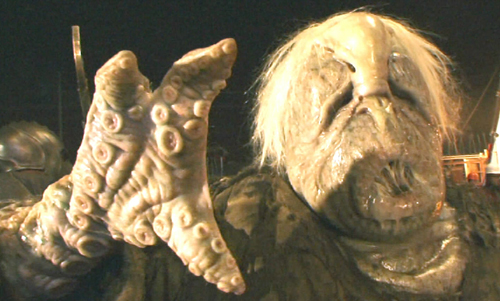 Ménage à Monster slowly stirs from its torpor, gathering the strength to birth more horrors into the world… But this isn’t a lame filler post (well not entirely) – unlike my last post, I actually have real content to present. It just happens to be on another website.
Ménage à Monster slowly stirs from its torpor, gathering the strength to birth more horrors into the world… But this isn’t a lame filler post (well not entirely) – unlike my last post, I actually have real content to present. It just happens to be on another website.
At the end of August, the good reptilians at Kobold Quarterly posted one of my creations on their website: the flesh mime.
I’ve never been completely satisfied with the direction 3e and 4e D&D took with the doppelganger. So I designed the flesh mime to move the monster away from being a sophisticated assassin infiltrating surface society, and return it to the predatory shapeshifter of the 1e Monster Manual that viewed humans as food. My second design goal was to make better use of the ‘spot the imposter’ trope (you know, ‘shoot both of us it’s the only way to be sure’) than the game had in the past, so flesh mime not only impersonates you and steals your abilities, but only the truly observant can tell you apart from the monster (I think that skills are an under-utilized dimension of 4e combat: ‘Insight, it’s not just for skill challenges anymore’).
The picture is J.J. Abrams’ updated version of the salt vampire from Star Trek (whose cameo was unfortunately cut from the finished film), which, it should be obvious by now, was one of the inspirations for the flesh mime.
While you’re at KQ, you should also check out the Nihilimentis, a monster I designed for them way back before Ménage à Monster existed. The Nihilimentis owes its inspiration to another monster from a long running SF show – the weeping angels from Doctor Who. I’m proud of the risks I took with this creature, but keep in mind that it was created before the Dungeon Master’s Guide II, so the damage output needs to be tweaked a little to use it in current games.
In house news, unpacking is just about done, and despite problems with the closing (which I’m told is not out of the ordinary), and the city digging a giant hole in our driveway on the day we took possession (not quite as normal), my partner and I are settling in very nicely. The city even fixed our driveway this week which is good, because I was half expecting the aforementioned giant hole to start spawning hordes of tiny stop-motion animated demons like the ones from The Gate. I hope there aren’t any zombie workers trapped in our walls – drywalling after they break out is a pain in the ass.
Random Encounters: Put on a Grey Ribbon
May 21, 2011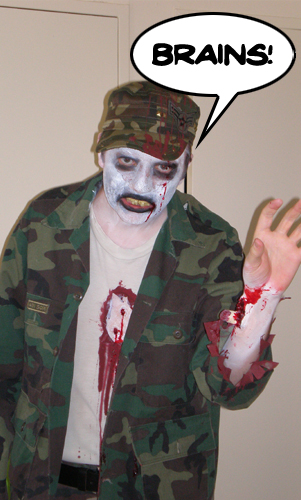 Thanks to myths and monsters week on Daily Planet, I discovered that May is Zombie Awareness month. According to the Zombie Research Society (who I guess are the ones who decided this… I wonder if they have a government grant?), the month of May was chosen because:
Thanks to myths and monsters week on Daily Planet, I discovered that May is Zombie Awareness month. According to the Zombie Research Society (who I guess are the ones who decided this… I wonder if they have a government grant?), the month of May was chosen because:
“Many films important to the evolution of the modern zombie are set in the month of May, from the original Night of the Living Dead, 1968, to the well received Dawn of The Dead remake of 2004. Also, because spring naturally brings with it a sense of renewal and hopefulness, May is the perfect month to emphasize continued vigilance in the face of the coming zombie pandemic.”
Well, as the picture can attest to (circa the 2008 Toronto Zombie Walk); I’m certainly not unaware of the coming zombie apocalypse (in the future, undead Canadians will look at me dressed up in that picture and be offended). And even though I’ve never really talked about the undead on this blog (hey, where’s the underwater beholder awareness month?), they are an important ingredient to any ménage à monster.
That said, zombie awareness month actually got me thinking about something else – fake undead (maybe it was the photo). During the days of 1st edition D&D (and bleeding over into 2nd), there was a popular trend of ‘gotcha’ monster design. That is, monsters that look like something they are not to trick adventurers into using ineffective tactics against them. The best example of this is probably the gas spore – a monster that looked just like a beholder, but exploded in a cloud of deadly spores if you panicked and hit it with a weapon (I happen to like the gas spore – but it probably has more to do with nostalgia and the sweet Trampier illustration than good design), but it was by no means the only one. That’s where the fake undead come in. These were a category of gotcha monsters that looked like undead (and sometimes acted like it too)… but weren’t. So while your party’s cleric was busy wasting time trying to turn undead, it was killing the rest of you in some non-undead way.
Now some people like using this kind of monster, and maybe I’ve been brainwashed by post 3rd edition thinking, but these creatures just strike me as cheesy one-shot adversaries designed solely to exploit the game’s mechanical assumptions. But complaining about the design choices of monsters from the dustbin of D&D’s history doesn’t get us anywhere. If Zak from Playing D&D with Pornstars can rehabilitate the gas spore, then perhaps some of D&D’s fake undead can be salvaged as well:
- Adherer (from Fiend Folio): This humanoid was covered in loose folds of flesh that made it look like a mummy. It secreted glue from its skin that made your weapons stick to it (I actually did use this monster in 2e, more for its sticky power than its resemblance to a mummy). Surprisingly, this monster has already been rehabilitated – by Paizo in their book Misfit Monsters Redeemed. Here they are presented as living relics of a horrible experiment conducted by phase spiders on the ethereal plane.
- Drelb (Monster Manual II): A creature native to the plane of negative energy that looks like a wraith, and is summoned to guard an area or treasure. It cannot be turned, but tricks clerics who try to do so by appearing to move away, but actually shrinks and moves forward. The drelb’s special power is as lame a
 s a monster that attacks by pretending its going down a flight of stairs. To rehabilitate it I’d get rid of the shrinking thing and quit making it imitate wraiths. Now it’s a malevolent blot of pure necrotic energy that can only manifest in the zone it was summoned to protect (using a mechanic like 4e homunculi). To keep its anti-clerical theme it could do something bad (like an attack or imposing a condition) to anyone who used a power in its aura with the radiant keyword (or someone who used a healing power instead).
s a monster that attacks by pretending its going down a flight of stairs. To rehabilitate it I’d get rid of the shrinking thing and quit making it imitate wraiths. Now it’s a malevolent blot of pure necrotic energy that can only manifest in the zone it was summoned to protect (using a mechanic like 4e homunculi). To keep its anti-clerical theme it could do something bad (like an attack or imposing a condition) to anyone who used a power in its aura with the radiant keyword (or someone who used a healing power instead). - Gambado (from Fiend Folio): This one-legged creature uses a discarded skull as a head prosthetic, digs a hole in the ground, and when some adventurer comes to investigate the skull, it jumps out at them. I’m amazed this thing survived two editions of the game. I’d take away the ambush predator aspect of this monster and instead focus on the bone stealing and collecting. Reimagined, it becomes a sort of necromantic caddisfly that forms a cocoon out of bones. It can animate its grisly shell to move around the battlefield and attack. Perhaps absorbing new bones heals it, or maybe the gambado grows weaker as its protective cocoon is shattered (yes the name comes from ‘leaping and springing’, I guess it could leap out at you and try to bite your face off it its cocoon is destroyed).
- Necrophidius (from Fiend Folio) and Yellow Musk Zombie (from Monster Manual II): OK, neither one of these monsters really needs to be rehabilitated. With the addition of knowledge checks to the game in 3e, these go from gotcha to cool. Construct made out of snake bones that can hypnotize you by swaying back and forth? Awesome. Killer plant that controls you by planting a seed in your head? Even more awesome. I’m willing to admit when my idea falls apart.
- Pseudo-Undead (from Monster Manual II): The worst culprits of the lot, pseudo-undead are humanoids that look like undead, but have none of their special abilities. Like a Scooby-Doo villain, they spend their pathetic lives hoping others will be too scared to attack them. Here’s a tidbit: “Pseudowraiths and pseudospectres cannot fly but walk so lightly as to leave no trace, and are often thought (unless closely observed) to be floating above the surface, although this is an illusion.” Like the gambado, this is going to take a bit of a stretch. First I’d call the creature something different, like a necroclone. Then, taking a bit of inspiration from the myrmarachne melanotarsa, the monster becomes a shapeshifter with a taste for rotting, undead flesh. It can mimic corporeal undead so fully (and is resistant to disease and necrotic damage) that it lives among colonies of ghouls, and packs of zombies. These are not only the necroclone’s preferred food source, but they also provide the monster with protection, since few other monsters would target a large group of dangerous undead.
That covers 1e’s core monster books, but I’m sure later supplements, as well as Dragon and White Dwarf, hold more examples. Maybe someday I’ll even get around to statting these beasts up.
Alternate Histories
January 21, 2011Alternate histories and rpgs have a long relationship, one that has moved beyond settings (say, like the alternate weird west of Deadlands), to the games themselves. Let me explain. A popular trend in the internet fuelled ‘old-school renaissance’ of role-playing games is to imagine (and then create) the games that ‘could have been’ but weren’t made. You’ve got the B/X Companion (the imagined continuation of the Moldvay/Cook Basic and Expert D&D rules which were abandoned in favor of the BECMI sets), Adventures Dark and Deep (a hypothetical version of 2E D&D if Gygax had stayed with TSR), Spellcraft and Swordplay (a game that adheres to the original Chainmail combat conventions instead of the ‘alternate’ D20 mechanic presented in OD&D), even Stellar Battles (a ‘what-if’ scenario that has Gygax making an RPG of Star Wars in the early 80s and then losing the license).
Now there’s a lot I like about the old-school (the art for one, most obviously), but there’s a lot I don’t like as well (player vs. DM relationship, highly idiosyncratic systems, rules that rely on arbitrary DM fiat), and since the old-school rules are the thing I have the most problem with I’m not all that interested in these systems (I do admire the passion that goes into these projects though). That said, I really like the idea of taking an already existing idea or product and tweaking some of the facts as a way of re-imagining it and making something new (probably why I was such a huge fan of the What If? series from Marvel). It’s a great source of inspiration for monsters and adventures – another tool in a DM’s kit that’s not to be ignored (and the complete premise of the excellent Star Trek reboot).
The thing that got me thinking about all this alternate history and re-imagining was a post over at the Rue-Morgue website that directed me to artist Sean Hartter’s blog and this old post where he created a series of alternate reality movie posters. Here are a few highlights (click on them for a bigger picture), but I strongly recommend checking out the post and seeing all he has to offer (he’s selling them as full-blown posters as well). 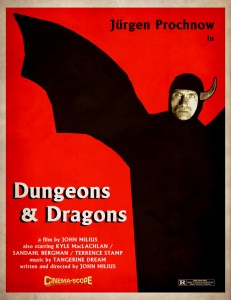
First we’ve got an 80s live action movie of the Dungeons and Dragons cartoon, starring Jurgen Prochnow (the captain from Das Boot, also collectively known, along with Edward James Olmos, and Bryan Adams, as ‘my people’) as Venger. Written by the guy who gave us Dirty Harry and Conan the Barbarian, with trippy, synth (probably too loud) background music by Tangerine Dream. If this movie had been made I can totally see it replacing The Sword and the Sorcerer in my childhood mythology.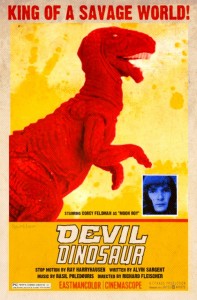
The next poster asks the question: what if Ray Harryhousen’s pet project wasn’t Greek mythology, but Jack Kirby monster comics? The answer, an awesome vehicle for a pre-Michael Jackson Corey Feldman with an epic score by Basil Poledouris (hmm, another Conan connection), is Devil Dinosaur.
Then comes a much more serious and early version of Ghostbusters, starring the greatest actors of 60s era horror, with a very freaky Bette Davis as Zuul (Bette David eyes indeed). It only makes sense such a pedigree would be rounded out with a writer like Robert Bloch (the man behind Psycho).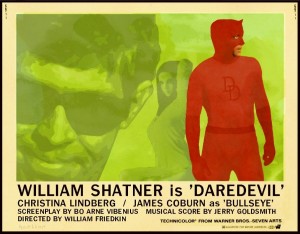
The next poster has nothing to do with monsters, but I had to include it because I’m always bugging my friend about liking Daredevil so much (I shouldn’t make fun, especially since my favorite hero is Dr. Strange, so I’m in no position to be throwing stones, but what are you going to do?). It stars William freakin’ Shatner… need I say more? I will anyway. This movie would have Daredevil bare-knuckling in a 70s hell’s kitchen, and with Friedkin at the helm (who did the Exorcist and Cruising), you know it would be a much grittier New York than we saw Ben Affleck in, filled with violence, vice, and exploitive nudity (a pre-imagining of Marvel Knights maybe?).
The last entry isn’t really a poster but the package for the Atari 2600 game for Cloverfield, if those two cultural artifacts had come about in the same era. This one cracks me up, because as anyone who’s ever played the E.T. game knows, what you see on that screen shot would have been the whole game (though I don’t think it’s possible for any game to be worse than E.T.).
Like a lot of great art, these pictures do so much with very little (visually, obviously a lot of thought went into the era appropriate style and credits). In my own way, I guess I’m so jazzed up about re-imaginings and alternate histories, because that’s one of the things I’m trying to do here. You could call Monsters of the Hyborian age a ‘what-if’ scenario where the creators of 4e D&D went back to one of the literary inspirations of the game instead of distancing themselves from it.


